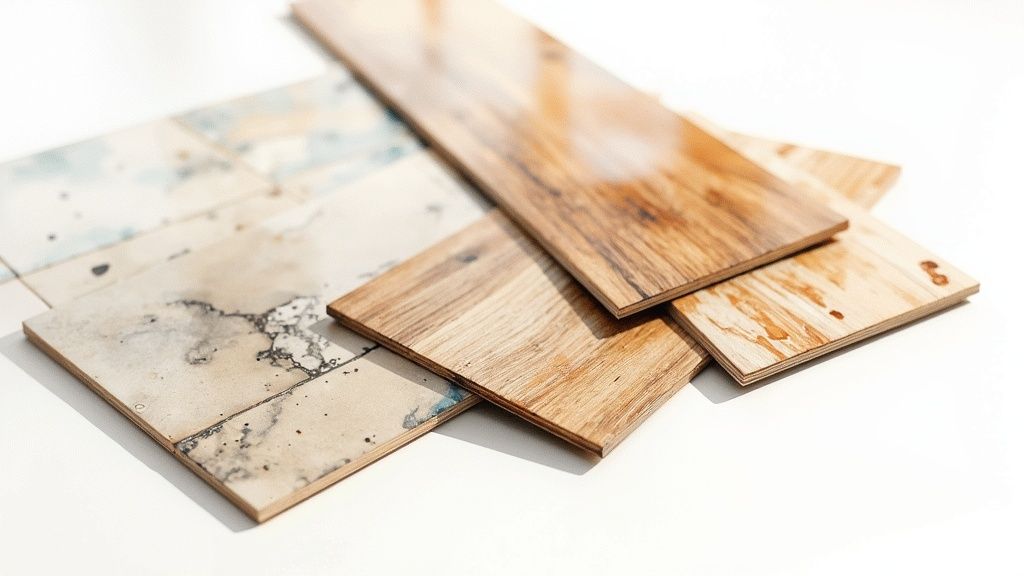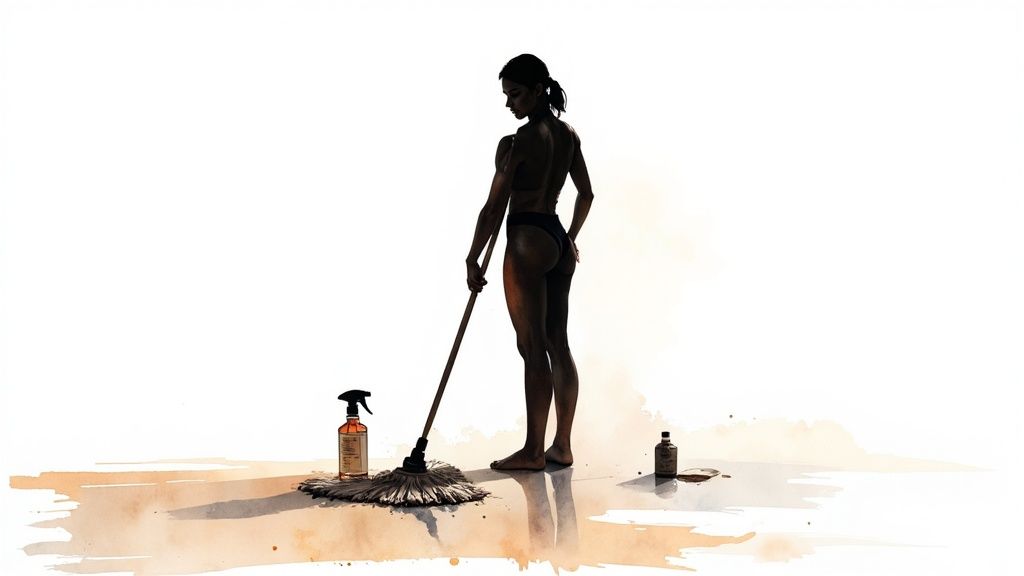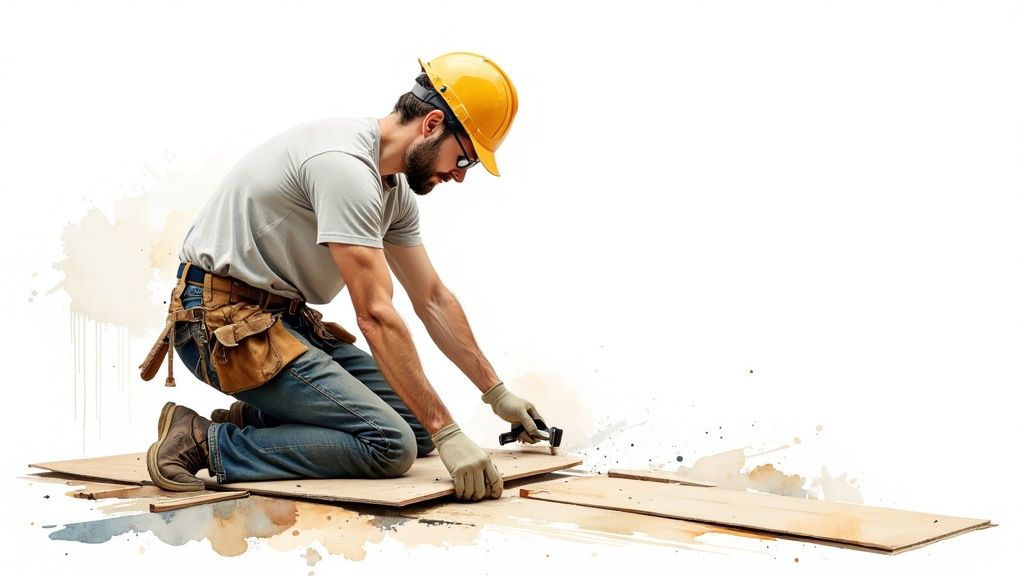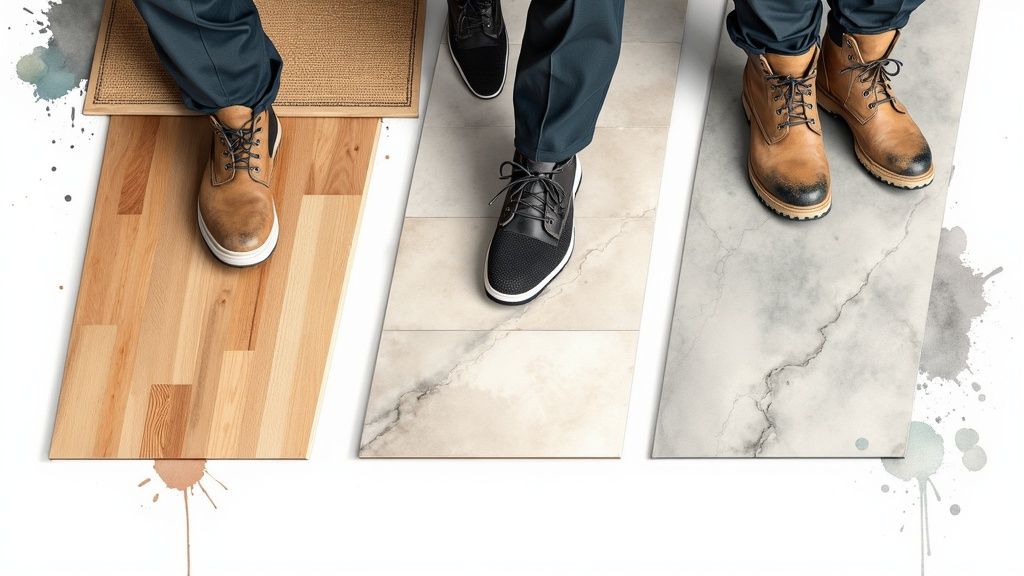When choosing flooring for high-traffic areas, the goal is to find the perfect balance between extreme durability, manageable maintenance, and the right look for your space. The most reliable options are typically porcelain tile, luxury vinyl plank (LVP), and epoxy-coated concrete. Each material offers a unique blend of toughness, but your final decision should be based on the specific demands of your environment, from aesthetic goals to your long-term budget.
How to Choose the Right Floor for Your Busiest Spaces
Picture the main entrance of a busy retail store, a hospital corridor, or a school hallway. These spaces require flooring that can withstand constant foot traffic, rolling carts, and daily cleaning without showing signs of wear. Choosing the wrong material is a direct path to premature scuffs, costly repairs, and a perpetually worn-out appearance.
Making a smart choice is a practical investment in the safety, cleanliness, and long-term value of your property. A floor in a high-traffic zone is like the tires on a delivery truck—it must endure constant friction, impact, and abrasion without failing. Overlooking these core performance factors will inevitably lead to costly problems.
Understanding Core Performance Factors
Before you start looking at samples, you need a clear checklist of what matters most. The best flooring for high traffic areas excels in three key areas, and understanding them will empower you to make an informed decision.
-
Wear Resistance: This is the most critical trait. The key question to ask is: "Can this surface handle thousands of footsteps, shuffling furniture, and abrasive dirt without scratching or fading?"
- Real-World Example: A hotel lobby floor must resist wear from luggage wheels, high heels, and constant foot traffic. A material with a high abrasion resistance rating, like commercial-grade porcelain tile, is essential to prevent it from looking dull and scratched within a few years.
-
Ease of Maintenance: How much time and money will it take to keep the floor looking pristine? A surface that resists stains and cleans up with simple methods saves significant labor costs over its lifetime.
- Real-World Example: In a busy café, coffee spills and food crumbs are a daily occurrence. A non-porous surface like luxury vinyl tile (LVT) allows staff to quickly wipe up messes without the risk of staining, unlike porous materials like natural stone that would require immediate, specialized cleaning.
-
Moisture Resistance: For areas like commercial kitchens, bathrooms, or building entrances, the floor's ability to repel water is non-negotiable to prevent warping, mold growth, and slip hazards.
- Real-World Example: The entrance of an office building in a rainy climate sees constant tracked-in water. Using waterproof LVP prevents the subfloor from getting damaged and avoids the swelling and buckling that would occur with a standard laminate floor.
This chart breaks down the durability ratings of today's most popular flooring materials when they're put to the test in high-traffic environments.
As you can see, porcelain tile consistently comes out on top with the highest durability rating, making it a go-to choice for the most demanding spaces.
High-Traffic Flooring Options at a Glance
To give you an actionable starting point, here’s a quick comparison of the top flooring materials based on what matters most in a busy environment. Use this table to narrow down your options based on your specific needs.
| Flooring Type | Durability Rating | Best For | Maintenance Level |
|---|---|---|---|
| Porcelain Tile | Excellent | Commercial entries, kitchens, bathrooms | Low to Moderate |
| Luxury Vinyl (LVP/LVT) | Very Good | Retail, healthcare, basements, homes with kids/pets | Low |
| Epoxy Concrete | Excellent | Garages, warehouses, industrial spaces | Low |
| Hardwood | Good | Living rooms, hallways (with proper care) | High |
| Laminate | Good | Offices, living areas, bedrooms | Low |
| Natural Stone | Very Good | Foyers, high-end commercial spaces | High |
This table provides a solid foundation for your decision-making process. The "best" flooring is always the one that aligns with the unique demands of your space.
For those evaluating options beyond residential use, a detailed guide to the best commercial flooring options can offer deeper insights. Ultimately, the secret to a long-lasting, great-looking floor is matching its technical strengths to the daily challenges it will face.
What Makes a Floor "High-Traffic"?
Not all flooring is created equal, a fact that becomes painfully obvious under the stress of constant, heavy foot traffic. To select the right material, you must look beyond surface appearance and analyze the technical specifications that define true durability. This is about understanding the engineering that separates a floor built to last from one that will look worn out in a year.
Think of it this way: you wouldn't use a standard passenger car tire on a heavy-duty construction vehicle. Both are tires, but only one is engineered for extreme conditions. Similarly, flooring for a bustling airport terminal needs specific, robust characteristics that a bedroom floor simply doesn't require. These traits are your guide to making a smart, long-term investment.
Decoding the Durability Ratings
To accurately judge a floor's potential, you need to understand the language manufacturers use to communicate performance. These rating systems allow you to compare products based on hard data, not just marketing claims.
-
PEI Rating (Porcelain Enamel Institute): This rating applies specifically to ceramic and porcelain tile and measures the glaze's resistance to abrasion. For high-traffic areas, this is a critical number. A tile with a PEI Class 4 rating is suitable for moderate to heavy commercial traffic (e.g., a restaurant dining room), but for the most demanding industrial environments (e.g., a factory floor), you must choose a Class 5 rating.
-
Wear Layer Thickness: For luxury vinyl (LVP and LVT), the wear layer is the most important feature. This is the transparent top coat that absorbs all the wear and tear, and it's measured in mils (one-thousandth of an inch). A thicker wear layer provides superior protection against scratches and scuffs. For any high-traffic commercial application, look for a wear layer of 20 mil or more.
-
Janka Hardness Scale: This scale is used for hardwood flooring and measures a wood species' resistance to denting and wear. The rule is simple: the higher the number, the harder the wood. For a busy family home or office, choosing a species with a high Janka rating, like Hickory or Brazilian Cherry, is a practical way to ensure it stands up to dropped objects and heavy furniture.
How to Apply This Knowledge
Let's make this practical. Imagine you are choosing the flooring for a busy veterinary clinic waiting room. This area sees heavy foot traffic, animal claws, rolling equipment, and requires frequent, rigorous cleaning.
- Bad Choice: A residential-grade LVP with a 12 mil wear layer would be a costly mistake. It would quickly show scratches from pet nails and wear patterns from foot traffic, requiring replacement within a few years.
- Good Choice: A commercial-grade LVP with a robust 28 mil wear layer or a porcelain tile with a PEI rating of 5 is the right tool for the job. These options are engineered to withstand this exact type of abuse and will maintain their appearance for years, providing a better return on investment.
Knowing these specifications is what separates a successful flooring project from a failed one when selecting the best high traffic area flooring solutions for businesses.
The single biggest mistake people make is choosing a floor on looks alone. A truly durable floor for a high-traffic area is a complete system—the right material, with the right technical ratings, installed the right way—all working together for long-term performance.
By focusing on these hard numbers and ratings, you eliminate guesswork. You can confidently select a floor that not only looks fantastic on day one but is engineered to stay that way under the relentless pressure of your busiest spaces.
Luxury Vinyl Flooring for Versatility and Durability

If you're looking for a flooring solution that can stand up to serious foot traffic while looking fantastic, it's time to get acquainted with Luxury Vinyl. Whether it's in plank (LVP) or tile (LVT) form, this material has exploded in popularity for one simple reason: it perfectly marries stunning looks with brute strength.
You get the rich, detailed appearance of natural wood or stone without the high maintenance. It's a pragmatic choice that works just as well in a bustling commercial space as it does in a busy family home.
The secret to its toughness lies in its multi-layered construction. While the core layers provide stability, the real performance comes from the transparent wear layer on top. This is the floor's invisible shield, taking all the abuse from daily life.
The Power of the Protective Wear Layer
The wear layer is the unsung hero of vinyl flooring, acting as a clear shield against scratches, scuffs, spills, and stains. It’s what keeps the beautiful printed design underneath looking pristine. The thickness of this layer is the single best indicator of how well your floor will hold up in a demanding environment.
- Actionable Takeaway: When specifying LVP for a commercial project, always check the product's technical data sheet. For a high-traffic area like a retail store or school hallway, insist on a wear layer of 20 mil or greater. This simple step ensures you get the durability you're paying for.
Real-World Example: A busy doctor's waiting room floor must endure hundreds of daily visitors, rolling chairs, and constant cleaning. By choosing an LVP with a commercial-grade 20 mil wear layer, the clinic ensures its floor stays looking professional for years, shrugging off abuse that would destroy lesser materials and avoiding the cost and disruption of a premature replacement.
Luxury vinyl flooring has become a top choice for high-traffic areas because of its remarkable durability. Significant advancements have increased its wear layer thickness, which now often falls between 0.5 to 1 mm for high-quality products. This robust surface provides superior resistance to scuffs and scratches, making it ideal for homes with pets or commercial spaces.
How to Weigh the Pros and Cons
Like any flooring, LVP and LVT come with their own set of strengths and weaknesses. Here's how to decide if it's right for you.
Key Advantages:
- Exceptional Water Resistance: Its layered makeup makes it almost completely waterproof. This is a game-changer for moisture-prone areas like kitchens, basements, and entryways.
- Comfort and Sound Dampening: Vinyl is noticeably softer and warmer underfoot than ceramic tile, making it more comfortable for employees who stand all day and helping to absorb sound in noisy environments.
- Simple Installation: Many modern vinyl flooring products come with a simple click-lock system. This makes installation a much faster and often cheaper process compared to other types of flooring.
- Low Maintenance: A quick sweep and the occasional mop are all it takes to keep luxury vinyl looking brand new. No special waxes or polishes are required.
Potential Disadvantages:
- Vulnerable to Sharp Objects: While it handles scuffs like a champ, a dropped knife or dragging a very sharp, heavy object across the surface can puncture or gouge the floor.
- Difficult to Repair: Unlike solid hardwood that can be sanded and refinished, a badly damaged vinyl plank or tile usually needs to be completely replaced. This can be tricky if you don't have spare pieces.
- Fading in Direct Sunlight: Over a long period, constant exposure to harsh UV rays can cause the colours in some vinyl products to fade. This is something to keep in mind for rooms with large, sun-facing windows.
Porcelain Tile: The Undisputed King of Durability
When your floors need to withstand an absolute beating, porcelain tile is in a league of its own. While it often gets lumped in with ceramic, porcelain’s unique manufacturing process—using finer, denser clay fired at much higher temperatures—gives it a superior edge for high-traffic spaces. The result is a tile that's incredibly hard and far less porous than its ceramic cousin.
That dense, non-porous composition is its superpower. It means porcelain shrugs off moisture, stains, and wear in a way other materials can't. This is precisely why it’s the go-to for environments that face constant abuse, from spills and heavy footfalls to the relentless rumble of wheeled carts in a warehouse.
How to Use the PEI Rating for Your Space
Before selecting a tile, you must consult the PEI (Porcelain Enamel Institute) rating. It’s a simple scale from 1 to 5 that tells you exactly how much abrasion the tile's glaze can handle. Using this scale is the most effective way to match the tile to your environment.
- PEI 1-2: For walls or very low-traffic floors like a guest bathroom.
- PEI 3: Good for standard residential floors, like kitchens and hallways.
- PEI 4: The right choice for busy homes and medium commercial spaces, like a doctor’s office or small retail shop.
- PEI 5: This is the heavyweight champion. It’s engineered for heavy commercial and industrial traffic—think shopping malls, airports, and factory floors.
Real-World Example: The kitchen in a busy restaurant demands a PEI 5 rated tile. It must endure staff running back and forth, dropped pans, constant scrubbing with harsh chemicals, and hot spills without chipping, staining, or wearing down. Choosing a lower-rated tile in this setting would be a costly mistake, leading to rapid failure and the need for a complete replacement, causing operational downtime.
"Porcelain tile is renowned for its exceptional durability in high-traffic areas. It is resistant to scratches, stains, and moisture, making it a preferred choice for spaces like kitchens and entryways. With proper installation, it provides a long-lasting solution that supports both aesthetic appeal and practical durability."
Balancing Toughness with Practical Considerations
As tough as it is, porcelain isn’t perfect. Its incredible hardness is also a drawback—it’s unforgiving underfoot and can be cold, which may be a comfort issue in certain settings.
Installation is another critical factor. This is not a DIY-friendly project. The tiles are heavy, difficult to cut cleanly, and require a perfectly level subfloor to prevent cracking under pressure. A poor installation will completely negate porcelain's durability, making professional installation essential.
However, when installed correctly, its longevity is unmatched. Data shows that a well-maintained porcelain tile floor can last for 50 years or more, offering an excellent long-term return on investment. You can find more great insights on porcelain tile performance at Consumer Reports.
Epoxy and Concrete for Industrial Strength

When you need a floor that is utterly seamless and built like a tank, nothing comes close to sealed concrete and epoxy coatings. These are high-performance systems designed for the toughest commercial and industrial spaces where durability is the number one priority.
Real-World Example: An auto repair shop floor must endure the constant weight of vehicles, the impact of dropped tools, and corrosive chemical spills like oil and brake fluid. An epoxy coating creates a single, rock-solid shield over the concrete slab that resists all of this abuse, making it easy to clean and maintaining a professional appearance.
How Protective Coatings Deliver Value
Don't mistake epoxy for a simple coat of paint. It’s a two-part resin system that chemically bonds with the concrete, creating a tough, non-porous surface that’s significantly stronger than the concrete it protects.
By sealing the porous concrete, epoxy blocks moisture, oil, and chemicals, preventing damage and dramatically extending the floor's lifespan. This makes it one of the best flooring options for extreme high-traffic areas and simplifies maintenance routines.
- Actionable Benefit: Epoxy is a smart financial choice for commercial buildings. By providing a chemical-resistant shield, an epoxy coating can easily triple the life of a concrete floor. For a 5,000-square-foot commercial space, this can translate into savings of up to $10,000 per year in maintenance and repair costs compared to less resilient flooring.
Aesthetics Meet Unyielding Function
Industrial-grade strength doesn't mean settling for a dull, grey slab. Both sealed concrete and epoxy offer surprising design flexibility, proving that function and form can go hand-in-hand.
- Polished Concrete: For a clean, minimalist aesthetic, polished concrete is a fantastic choice. The concrete is ground down and polished to a high-gloss finish that’s both visually stunning and incredibly tough, making it a favorite for modern retail stores, art galleries, and office spaces.
- Epoxy Finishes: This is where you can truly get creative. Epoxy comes in a huge spectrum of colors and can be customized with decorative flakes or metallic pigments. Businesses can embed company logos, create custom patterns, or mark out safety zones and walkways directly into the floor.
The real game-changer with epoxy and sealed concrete is that they are seamless. No grout lines or joints means there are no weak spots for dirt, grime, or bacteria to hide. This makes the floor exceptionally easy to clean and far more hygienic.
Of course, even the toughest surface needs to be safe. You can learn more about boosting floor safety in our guide on industrial non-slip mats.
Protecting Your Investment with Entrance Matting
The smartest and most cost-effective way to protect your new high-traffic floor begins at the front door. A high-quality entrance matting system is the single most critical defense against the dirt and moisture that cause wear and tear.
Think of it as the ultimate gatekeeper for your building. Studies show that a well-designed matting system can trap up to 80% of all dirt, moisture, and debris before it gets tracked inside. This massively reduces the abrasive grit that scratches surfaces and the moisture that creates slip hazards and long-term damage.
How to Implement the Three-Zone System for Maximum Protection
For a matting system to be truly effective, it must be structured in three distinct zones. This approach progressively cleans shoes as people walk in, ensuring maximum particle and moisture removal.
-
Zone 1: The Scraper Mat (Outdoor): This is your first line of defense. Placed outside the entrance, its aggressive, textured surface scrapes off heavy debris like mud, snow, and large dirt particles.
- Real-World Example: At a construction site office, a heavy-duty rubber scraper mat outside the door prevents workers from tracking thick mud and gravel onto the interior floors, saving hours of daily cleaning.
- Zone 2: The Scraper/Wiper Mat (Indoor/Vestibule): Positioned just inside the doorway, this mat has a dual function: it continues to remove smaller debris while also beginning to absorb moisture.
- Zone 3: The Wiper Mat (Indoor): Located fully inside the building, this mat’s primary job is to absorb any remaining moisture and trap fine dust, ensuring shoes are clean and dry before they touch your main flooring.
An effective entrance matting system is so much more than a simple welcome mat; it's a serious cost-saving tool. By trapping dirt at the door, you drastically cut down on cleaning labor and supply costs, extend the life of your expensive flooring, and significantly reduce the risk of slip-and-fall accidents.
This proactive strategy is one of the most cost-effective ways to preserve the look and lifespan of the best flooring for high traffic areas. A small investment in the right mats pays for itself many times over. To dig deeper, check out our guide on why entrance mats are must-have items for every business.
Frequently Asked Questions About High-Traffic Flooring

Choosing the right flooring involves practical questions. Here are clear, actionable answers to help you make a confident decision.
How Do I Balance Durability with My Budget?
The smartest approach is to calculate the total cost of ownership, not just the upfront price. A cheaper initial option can cost you far more in the long run through repairs and premature replacement.
- Actionable Strategy: Compare two options. A low-cost laminate might save you money today, but if it needs to be replaced in 7 years, its lifetime cost is high. A porcelain tile floor, while more expensive initially, can last over 50 years. Divide the total cost (materials + installation) by the expected lifespan in years for each option. This will reveal the true long-term value and help you make the most budget-friendly decision.
What Is the Best Flooring for Homes with Pets and Kids?
For a busy home with pets and kids, you need a floor that excels in three areas: scratch resistance, stain resistance, and ease of cleaning. Luxury Vinyl Plank (LVP) and porcelain tile are the top contenders.
Their non-porous surfaces prevent spills from soaking in, making cleanup simple. Their hard-wearing top layers are engineered to withstand the daily abuse of pet claws and dropped toys, allowing you to enjoy your home without constantly worrying about your floors.
How Much Does Installation Affect Flooring Performance?
Installation is not just the final step; it is one of the most critical factors in your floor's long-term performance and durability. An improper installation can cause even the most expensive material to fail.
- Real-World Consequence: If a subfloor isn't perfectly leveled before installing LVP, the click-lock joints can come apart under foot traffic, creating gaps and tripping hazards. For tile, an uneven subfloor will cause the tiles to crack under pressure. Professional installation ensures the job is done right, protecting your investment.
A professional installation is crucial for ensuring your floor's warranty remains valid. Manufacturers often void warranties if the flooring is not installed according to their specific guidelines, leaving you unprotected against product defects.
Your flooring is a major investment, and protecting it starts right at the door. Mats4U provides high-performance matting solutions designed to trap dirt and moisture, extending the life of your floors while making your space safer and cleaner. Explore our collection of durable entrance and anti-fatigue mats at https://www.mats4u.com to find the perfect defense for your space.







